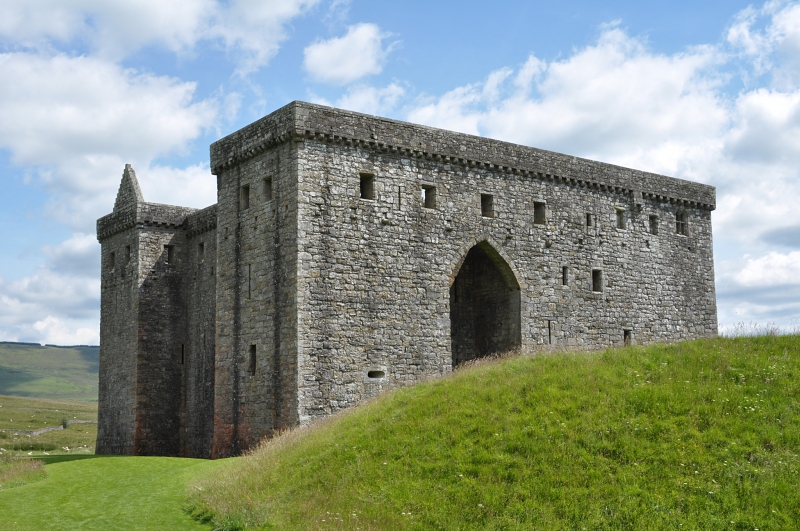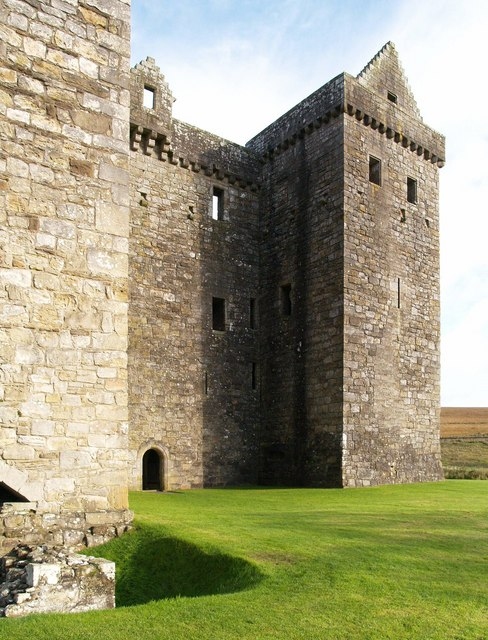
We are away by 8:30, driving through border country; a land that, even before Hadrian built his wall, had an imaginary line drawn in the dirt, daring inhabitants on either side to cross it.
It is a land of banditry, bloodshed and battles where, for centuries, men brashly took what they wanted and called it their own. A turbulent frontier; a land that appears to have never been tamed, a defiant land, rolling and ranging wildly for as far as the eye can see.
Through the countryside we drive, heading ostensibly toward the wonders of Hadrian's Wall. But up ahead, rising on a motte and surrounded by barren moorland, stands a castle. I recognize it immediately from books I have read. We've passed into Scotland without my knowing it (!) and ahead lies a most impressive and oppressive fortress – Hermitage Castle.
We pull into a small car park near Hermitage Water and cross the footbridge, taking a moment to watch a small black and white bird that sits on a boulder in the fast flowing stream. His tail bobs up and down, up and down. I assume he is hunting insects, though we never see him catch one. My British Wildlife book that I bought later in Melrose lists this bird as a Dipper and notes that they plunge into water to feed.
On the other side of the bridge is the gate – the padlocked gate. Opening time is 10:00AM according to the sign, but it's only 9:30 by my watch. It is a defiant land though, so over the gate we clamber and up the path we saunter. I mentally prepare a response, i.e. "What gate?" "No habla Ingles" or "We came in the back way," gesturing to the vast uplands that encircle the castle, in case someone of authority shows up.
Home to Lord Soulis in the 13th century, there are many legends, which compete with history, surrounding Hermitage. William, Lord Soulis, who had royal blood in his veins, was Warden of the Scottish Marches in the days of Robert the Bruce. According to writings of the time, he forfeited his possessions for his part in a conspiracy designed to make him king and was executed for treason.
In legend, Lord Soulis was in league with demons, and used his vassals as beasts of burden, boring holes in their shoulders and yoking them to sledges on which they dragged the materials for building the castle. And according to this legend his neighbors, having had enough of his diabolical deeds, put him to death by boiling him in a cauldron by the Nine Stane Rig, an ancient stone circle nearby.
The castle passed through the hands of many recognizable names throughout the centuries, including William Douglas, Hugh Dacre and the Earl of Bothwell, who was visited here by Mary Queen of Scots. Sir Walter Scott was fascinated with Hermitage, which was also known as "The Strength of Liddesdale," and had his portrait painted with an eerie, mysterious Hermitage in the background.
There is nothing eerie or mysterious about Hermitage this day. Lit by bright sunlight and surrounded by sheep, to which we play shepherd as we walk around the castle, it is difficult to conjure the proper state of awe this imposing structure should evoke. I am finally in Scotland, standing in Scotland (wow), high atop the earthworks, a great bank which surrounds the castle.
From my perch I can see bright blue sky and big puffy white clouds and ... a man, walking up the path toward us. Uh-oh, busted, I think, wondering what he will do. We start walking back out the way we'd come, meeting the man about halfway on the path to the car park. Clad in brightly colored tartan trousers and sporting a waxed handlebar mustache, he nods his head and greets us with a mumbled "Good morning." At least he left the gate unlocked so we didn't have to climb back out.

Hermitage Castle is a semi-ruined castle in the border region of Scotland. It is under the care of Historic Scotland. The castle has a reputation, both from its history and its appearance, as one of the most sinister and atmospheric castles in Scotland.
Mary, Queen of Scots, made a famous marathon journey on horseback from Jedburgh to visit James Hepburn, 4th Earl of Bothwell there, only a few weeks after the birth of her son. They married shortly after the murder of her second husband Henry Stuart, regardless of the fact that Bothwell was implicated amongst the conspirators
Hermitage Castle is reputed to be haunted by Redcap Sly, de Soulis's familiar spirit, and by Mary, Queen of Scots.
Read more about Hermitage Castle at Wikipedia.